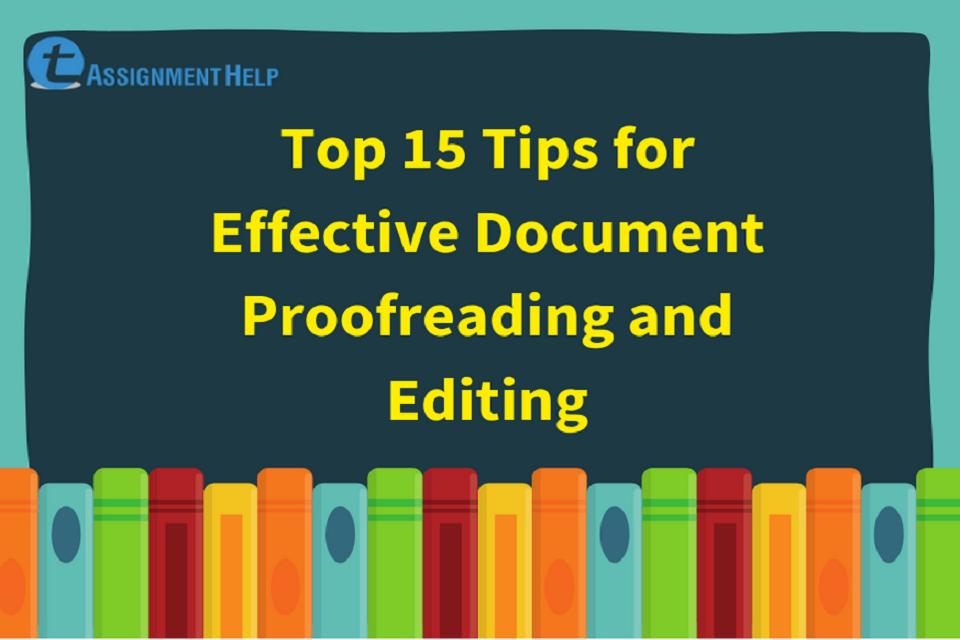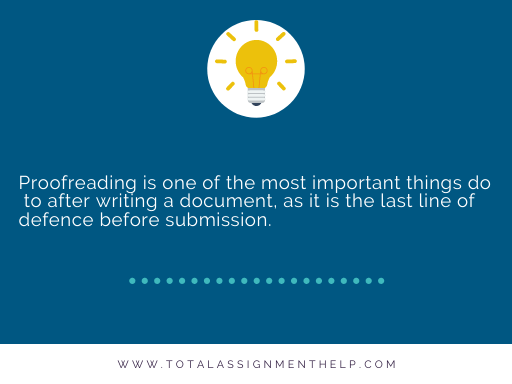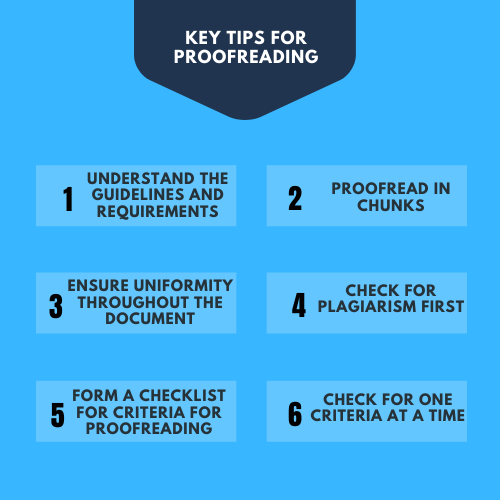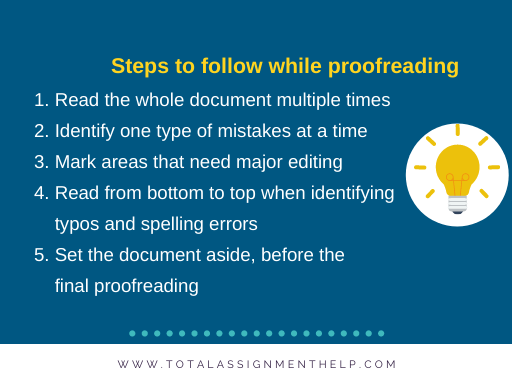Effective Document Proofreading and Editing is an important aspect of writing any document, and it should never be neglected or taken lightly, because no matter how perfect your writing skills are, there are always some issues which skip our mind, when we are writing the document.
Furthermore, Effective Document Proofreading and Editing the whole document before submitting is necessary as it helps in identifying the issues related to formatting, relevancy of the data, critical thinking, and lastly typographical errors.
Effective Document Proofreading and Editing is the last line of defence and hence you should set ample time for it, in order to maintain the quality of the document. Most of the time, people and specially students, focus on writing their assignments and don’t even consider proofreading as one of the steps. This is not the best way to submit any assignment of written document, and as a consequence they end up losing a significant amount of marks of grades, which could have been easily avoided, just by proofreading the document and ensuring its quality.
How can Effective Document Proofreading and Editing enhance the quality of your assignment?
- Get Familiar with Effective Document Proofreading and Editing Guidelines: Granted that you must have already read the guidelines and the requirements of the document before starting the work, but doing this process once again is very important. This is because, while writing the content, many of the minute details regarding the formatting and minor issues with the deliverables might occur. It is not possible to Effectively Proofread and Edit a Document if you don’t have a frame of reference to compare it with, or a set of guidelines which you wish to follow. Understand what you are proofreading the document for, and what is should ideally look like.
- Take a break so as to achieve Effective Document Proofreading and Editing: Once you finish writing the document, you should set it aside for some time, say a few hours or overnight, and then proceed to proofreading it. This is because if you proofread the file right after writing it, chance are you will miss a majority of errors and mistakes, as your mind is revolving around all the points and terms that you have put in the document. This gets in the way of proofreading, as you tend to skip over the line and identification of mistakes is not done so efficiently. Thus, after writing the document take a break to take your mind off of the topic, for Effective Document Proofreading and Editing, or get one of your friends to do it, this will also help you in getting a second opinion on the quality of the document that you have just created.
- Avoid using Proofreading Tools: Try not to depend too much on proofreading tools to check the qualities of your document in one go. Most proofreading apps and soft wares do not work effectively. This is because the writing style of every individual is different and the apps is not equipped to accommodate them all. They tend to skip over a significant amount of errors and mistakes. If you utilize Effective Document Proofreading and Editing with an app, a majority of edited sentences will make much less sense than before, because they might not be in the same language of format as the rest of the sentences in the whole document, and that decreases its quality. You may however use it to check the various spelling of words in the document, and it can also be helpful in identifying the proper punctuation to some level.
- Proofread in Segments: Effective Document Proofreading and Editing requires you to take a break the contents in the documents into easy to handle sections, so that you don’t get distracted from the rest of the text. Take one or few paragraphs at a time depending on your speed and the time you have. Go through the selected paragraph line by line, keeping in mind the guidelines and formatting, in addition to the flow of ideas. You can even use a ruler to hide the following text in the paragraph to increase your level of concentration and finding the mistakes more easily.
- Understand the writing styles: As the style of writing differs for different types of articles and documents; such as academic essays, thesis, dissertation, blogs, articles, etc., they rules of writing of each of them also change. Effective Document Proofreading and Editing requires you to know about the basic rules and the type of language that should be used in the particular document that you may be proofreading. This way you can identify if the language followed and terminology used in the document is appropriate or not.
- Move from bottom- up: This is a common proofreading technique used by many people, because it is effective. While going through your document for the first time after writing it, proofread it backwards, and start from the bottom and move up. This allows you to not get distracted from the contents of the document and you can manage the content more easily. Pick one paragraph at a time of a few lines and check them for errors in grammar and sentence formation. Another Effective Document Proofreading and Editing involves reading the lines backwards you can put your focus on each word and break the cycle of looking at a group of words and phrases at a time. This technique has proven to be very effective for identifying typos, spelling and grammatical errors in the sentences.
- Proofread for one criteria at a time: It can be very daunting to proofread the whole document for everything at once and make it perfect in one go. (In a perfect world, there would be no need for proofreading at all!) Instead, you should set a criterion and look for one thing at a time. This way you can focus on finding and correcting one type of mistake at a time. This particular method is found to be the most effective in finding even minute errors in the document, which why many coders use this process to find errors in the codes.
- Effective Document Proofreading and Editing requires a Checklist: Identify mistakes and error which are most commonly committed by you or the writer of the document and make a list. Keep this list with you while proofreading the document and look for these as there is a higher chance of existence of these errors.
- Check for Plagiarism and Authenticity: This is primary criteria in most publishing houses and universities. It is necessary that the content in the document should be original and no plagiarised from some other place. If the content is taken from somewhere else it should be properly cited and the owner of the content must be acknowledged. You can also check that the referencing and the citation is done using the right formatting and that the references coordinate with the information.
- Do not edit too much: It is fairly easy to get carried away while editing your document when you’re proofreading. This should be avoided, as while proofreading is focussed on finding the mistakes and thus you end up changing what you shouldn’t have. Instead try to only change what is necessary and highlight the portions where you feel doubtful. This way you can come back to the text after completing the correction in the rest of the file and check if it still needs to be edited.
- Effective Document Proofreading and Editing also requires Reading loud: Once you have done basic editing for minor errors, read the whole document aloud. It is widely approved that our ears can help us subconsciously in identifying the mistakes in the text, and when you read it yourself you can find out the faults in flow of thought throughout the paragraphs.
- Find errors in writing styles: Once you are done with finding and correcting the basic errors in your file, you should now look for any mistakes which have been made in the style of writing adopted by the author. They can be anything, from improper formation of sentences, using the wrong terminology, writing in first person where not required etc. This step is quite important as while checking for spelling and grammatical errors, you will not find these types of mistakes in the document. Therefore it is one of the most important steps of proofreading.
- Presence of Critical Thinking in the document: This can be considered as one of the most important aspects of writing, as critical thinking can take any piece of writing from mediocre to excellent. Critical thinking is the way the flow of thoughts and ideas proceeds in any piece of writing. It is how well the particular question is answered and how the language and the words have been chosen to express the information present in the document. Effective Document Proofreading and Editing also requires you to go through the document line by line that writing language follows critical thinking.
- Guidelines Adhered To and Deliverables Met: Make sure that the document follows the rules specified at the time of writing related to the content and the various topics it should cover. Keep a list or the requirements file handy and check each of the deliverables as you read the file. This will ensure that you haven’t missed any important topics which needed to be discussed in the file, as that can result in loss of grades and other complications after you have submitted or published the file.
- Final Reading: Now that you have established the deliverables and made the corrections in the file, it now time to do a final proofread of the whole document from the beginning. Read the document from start to bottom, if it is too big to it in one sitting, take breaks in between. You can even take help from text to speech tool in MS Word or any other software you may be using. It selects a portion or whole of the text and reads it our loud so you can hear can identify the mistakes. You can take the help of a friend for the final proof reading as well as they can give you a different perspective from a reader’s from point of view who may not be that familiar with the topic.
This concludes our list of tips to proofreading your document. You can these tips to proofread any piece of writing or any length. With colleges and Universities, giving strict marking criteria and deadlines for assignments and papers, it is very important that the final document that you submit is of utmost quality and for that you need to put most of your efforts in writing as well as proofreading.
Effective Document Proofreading and Editing before submitting is always the best practice which will definitely help you in the long run, in your academic scores and your careers while writing any emails, or presentations.
Hope this article help you in finding out the most Effective Document Proofreading and Editing techniques to achieve for maximum quality and effect.







